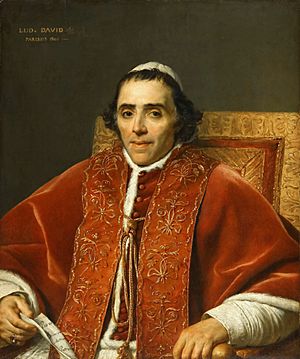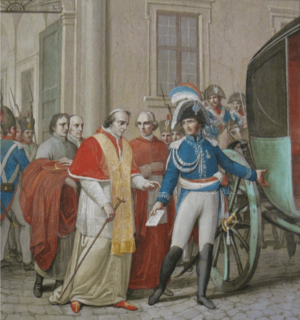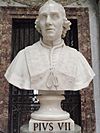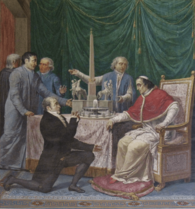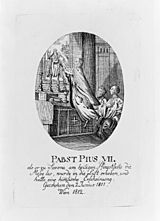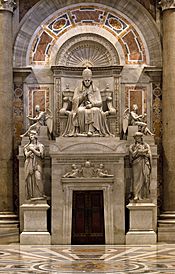Pope Pius VII facts for kids
Quick facts for kids Pope Servant of God Pius VII |
|
|---|---|
| Bishop of Rome | |
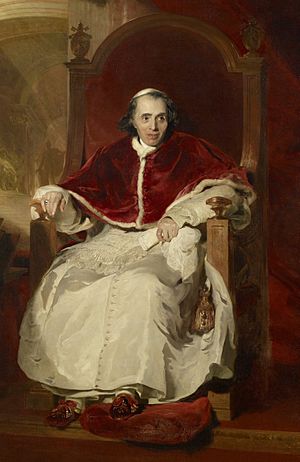
Portrait by Thomas Lawrence, 1819
|
|
| Church | Catholic Church |
| Papacy began | 14 March 1800 |
| Papacy ended | 20 August 1823 |
| Predecessor | Pius VI |
| Successor | Leo XII |
| Orders | |
| Ordination | 21 September 1765 |
| Consecration | 21 December 1782 by Francesco Saverio de Zelada |
| Created Cardinal | 14 February 1785 |
| Personal details | |
| Birth name | Barnaba Niccolò Maria Luigi Chiaramonti |
| Born | 14 August 1742 Cesena, Papal States |
| Died | 20 August 1823 (aged 81) Rome, Papal States |
| Previous post |
|
| Motto | Aquila Rapax ("Rapacious eagle") |
| Signature | |
| Coat of arms |  |
| Sainthood | |
| Venerated in | Catholic Church |
| Title as Saint | Servant of God |
| Attributes |
|
| Other Popes named Pius | |
Pope Pius VII (born Barnaba Niccolò Maria Luigi Chiaramonti; 14 August 1742 – 20 August 1823) was the leader of the Catholic Church. He also ruled the Papal States from March 1800 until his death in August 1823. Before becoming pope, Chiaramonti was a monk of the Order of Saint Benedict. He was also a well-known theologian and a bishop.
Chiaramonti became the Bishop of Tivoli in 1782. He then became the Bishop of Imola in 1785. In the same year, he was made a cardinal. The French Revolution began in 1789, bringing anti-religious governments to power in France. In 1798, during the French Revolutionary Wars, French troops led by Napoleon Bonaparte invaded Rome. They captured Pope Pius VI and took him to France, where he died in 1799.
After about six months without a pope, Chiaramonti was elected in 1800. He chose the name Pius VII. At first, Pope Pius VII tried to work with Napoleon. He signed the Concordat of 1801, which gave Catholics in France religious freedom. He even attended Napoleon's coronation as Emperor of the French in 1804.
However, in 1809, Napoleon invaded the Papal States again during the Napoleonic Wars. Pius VII responded by officially removing Napoleon from the Church. Napoleon then took Pius VII prisoner and sent him to France. Pius VII remained a prisoner until 1814. After France was defeated, he was allowed to return to Rome. He was welcomed as a hero and a defender of faith.
Pius VII lived the rest of his life in peace. During his time as pope, the Catholic Church in the United States grew a lot. He created several new dioceses there. Pope Pius VII died in 1823 at the age of 81. In 2007, Pope Benedict XVI started the process to make him a saint. He was given the title Servant of God.
About Pope Pius VII
His Early Life
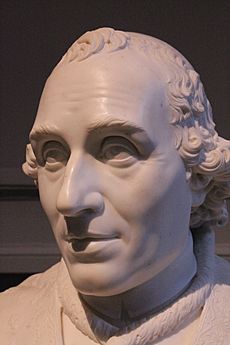
Barnaba Niccolò Maria Luigi Chiaramonti was born in Cesena, Italy, in 1742. He was the youngest son of Count Scipione Chiaramonti. His family was noble but not very rich.
When he was 14, he decided to become a monk. On October 2, 1756, he joined the Order of Saint Benedict at the Abbey of Santa Maria del Monte in Cesena. Two years later, he became a full member and took the name Gregorio. He taught at Benedictine colleges in Parma and Rome. He became a priest on September 21, 1765.
Becoming a Bishop and Cardinal
His relative, Giovanni Angelo Braschi, was elected Pope Pius VI in 1775. This helped Gregorio's career. In 1773, Gregorio became Braschi's personal confessor. In 1776, Pius VI made the 34-year-old Gregorio an honorary abbot of his monastery.
In December 1782, the pope made Gregorio the Bishop of Tivoli, near Rome. Then, in February 1785, Pius VI named him a Cardinal-Priest and the Bishop of Imola. He held the Imola position until 1816.
When the French Revolutionary Army invaded Italy in 1797, Cardinal Chiaramonti advised people to be calm and accept the new government. He told the people of his diocese to follow the French army's authority. In a Christmas speech that year, he said that being a good Catholic and living in a democracy were not against each other. He stated that "Christian virtue makes men good democrats."
His Time as Pope
| Papal styles of Pope Pius VII |
|
|---|---|
 |
|
| Reference style | His Holiness |
| Spoken style | Your Holiness |
| Religious style | Holy Father |
| Posthumous style | Servant of God |
His Election as Pope
After Pope Pius VI died in 1799, cardinals met to choose a new pope. This meeting, called a conclave, started on November 30, 1799. It took place in a monastery in Venice. There were several candidates, but they couldn't agree for months.
Finally, on March 14, 1800, Chiaramonti was elected pope. He was a compromise choice. He took the name Pius VII to honor the previous pope. He was crowned on March 21 in a special ceremony. The French had taken the old papal crowns, so he wore one made of paper. He then traveled to Rome by ship.
Working with Napoleon and His Exile
One of Pius VII's first actions was to appoint Ercole Consalvi as his chief secretary. Consalvi went to France and worked out an agreement with Napoleon, called the Concordat of 1801. This agreement recognized Catholicism as the religion of most French citizens. It also gave the Church some rights, like the pope being able to remove bishops. In return, the Church gave up claims to lands taken during the revolution.
Pius VII tried to cooperate with Napoleon. He even attended Napoleon's coronation as emperor in 1804. He also joined France's trade blockade against Great Britain. However, Napoleon later invaded and took over the Papal States in 1809. He then took Pius VII as a prisoner and sent him away. The pope still called Napoleon "my dear son," but added that he was "a somewhat stubborn son."
Pius VII remained a prisoner until 1813, when he signed a new agreement called the Concordat of Fontainebleau. This agreement led to the release of cardinals who had been exiled. When these cardinals rejoined the pope, they convinced him to cancel the agreement. Pius VII began to do this in March 1814. This led the French to re-arrest some Church leaders. However, Napoleon gave up his power on April 11, 1814. As soon as Pius VII returned to Rome, he brought back the Inquisition and the list of forbidden books.
Pius VII's time as a prisoner made him seem like a hero. When he returned to Rome in May 1814, Italians welcomed him very warmly.
His Relationship with Napoleon
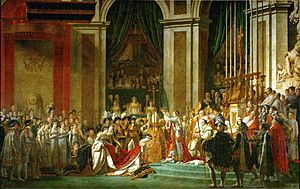
From his election until Napoleon's fall in 1815, Pius VII's time as pope was mostly about dealing with France. He and Napoleon were often in conflict. Pius VII wanted to be released from prison and wanted the Papal States back. He also wanted the release of 13 cardinals who had been exiled. These cardinals had disagreed with Napoleon's second marriage, believing his first was still valid.
Bringing Back the Jesuits
On July 31, 1814, Pius VII signed a special document called a papal bull. This document officially brought back the Society of Jesus, also known as the Jesuits, around the world. The Jesuits are a religious order of priests and brothers.
Against Slavery
Pius VII strongly spoke out against the slave trade. In 1815, he joined a declaration at the Congress of Vienna that called for an end to slavery. He wrote letters to the kings of France and Portugal, urging them to stop the slave trade. He said that selling people was an injustice to human dignity. In his letter to the King of Portugal, he wrote that he was sad the trade in Black people was still happening. He begged the king to use his power to end this "unholy and abominable shame."
Other Important Actions
Pius VII encouraged people to return to the values of the Gospel. He also made the feast of Our Lady of Sorrows a universal celebration on September 15. He spoke out against secret societies like Freemasonry and the Carbonari. He said that members of these groups should be removed from the Church.
Pius VII could speak several languages, including Italian, French, English, and Latin.
Supporting Arts and Culture
Pius VII loved culture and worked to improve Rome. He supported archaeological digs in Ostia, which uncovered ancient ruins. He also had walls and buildings rebuilt and restored the Arch of Titus. He ordered new fountains and public squares to be built. He also put up an obelisk at Monte Pincio.
The pope also made Rome a place for artists. He supported famous artists like Antonio Canova. He added many old books and writings to the Vatican Library. It was Pius VII who chose the yellow and white flag of the Holy See. This was a response to the French invasion in 1808.
Making Saints
During his time as pope, Pius VII made five people saints. These included Angela Merici and Francis Caracciolo. He also officially recognized 27 other people as "blessed," which is a step towards sainthood.
New Cardinals
Pius VII appointed 99 new cardinals during his papacy. These included important Church figures like Ercole Consalvi. He also named his two future successors, Pope Leo XII and Pope Pius VIII, as cardinals.
There is a story that on August 15, 1811, while celebrating Mass, Pius VII went into a trance and seemed to float towards the altar. This event surprised everyone, including the French soldiers guarding him.
Relationship with the United States
When the United States fought the First Barbary War to stop pirates from kidnapping Europeans, Pius VII praised them. He said the United States "had done more for the cause of Christianity than the most powerful nations of Christendom have done for ages."
For the United States, he created several new dioceses in 1808. These included dioceses for Boston, New York City, and Philadelphia. In 1821, he also created dioceses for Charleston and Cincinnati.
His Final Years
In 1822, Pius VII turned 80, and his health began to decline. On July 6, 1823, he fell and broke his hip. He was bedridden after that. In his last weeks, he often lost consciousness. He would sometimes whisper the names of the cities where the French had held him prisoner. With his chief secretary, Ercole Consalvi, by his side, Pius VII died on August 20, 1823.
He was first buried in the Vatican grottoes. Later, he was buried in a monument in St. Peter's Basilica after his funeral on August 25.
Becoming a Saint
| Servant of God Pius VII |
|
|---|---|
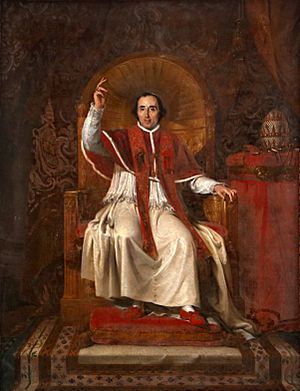 |
|
| Pope; Confessor | |
| Born | Barnaba Niccolò Maria Luigi Chiaramonti 14 August 1742 Cesena, Papal States |
| Died | 20 August 1823 (aged 81) Apostolic Palace, Rome, Papal States |
| Venerated in | Roman Catholic Church |
| Attributes | Papal attire Papal tiara Benedictine habit |
| Patronage | Diocese of Savona-Noli Persecuted Christians Prisoners |
In 2006, a request was made to the Holy See to start the process of making Pius VII a saint. On August 15, 2007, Pope Benedict XVI officially approved the start of this process. This means Pius VII was given the title Servant of God. Work began to collect documents about his life.
He has since been chosen as a special protector for the Diocese of Savona and for prisoners. In late 2018, the Bishop of Savona announced that the process for Pius VII's sainthood would continue. A special Mass was held in the Savona diocese on October 31, 2021, to formally begin the investigation into his life.
Monuments
Pope Pius VII's monument in St. Peter's Basilica was finished in 1831. It was created by the Danish sculptor Bertel Thorvaldsen.
See also
 In Spanish: Pío VII para niños
In Spanish: Pío VII para niños
- Apostolic Prefecture of the United States
- Cardinals created by Pius VII
- John Carroll, first US bishop
- List of popes
- Scipione Chiaramonti




